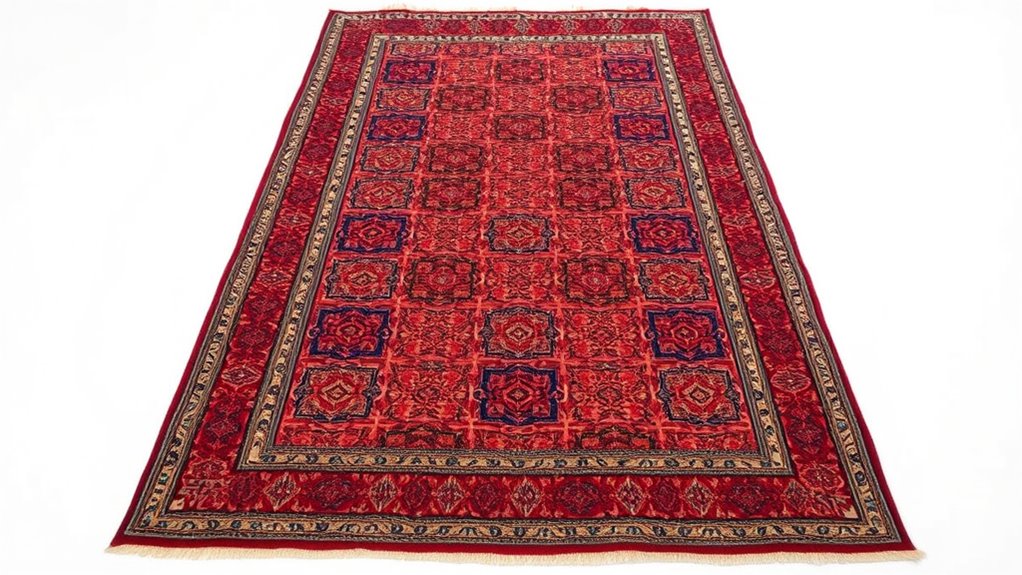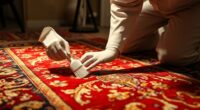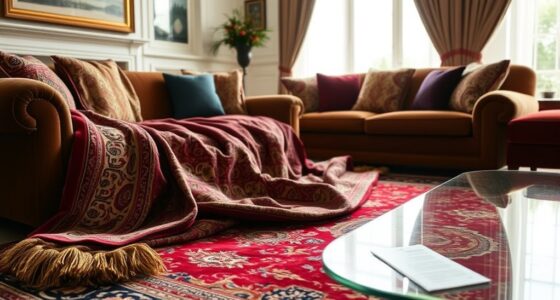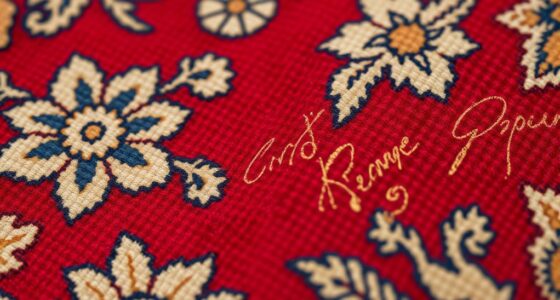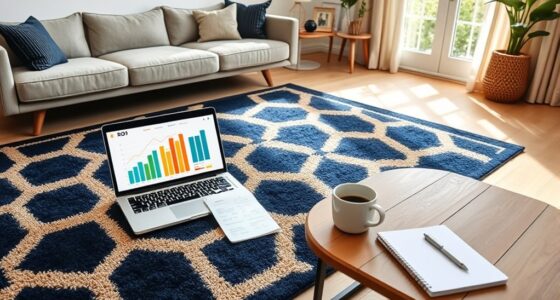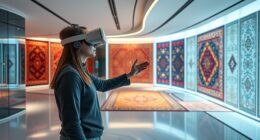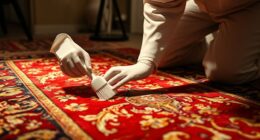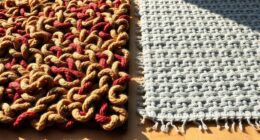To photograph your rug for insurance appraisals, start by cleaning and smoothing it out to show true condition. Use natural or soft lighting to capture accurate colors and avoid shadows. Take wide shots showing the entire rug, then focus on close-ups of patterns, textures, and any damage or wear. Keep your photos organized and stored securely. If you want to guarantee every detail is documented properly, continue exploring these best practices.
Key Takeaways
- Use well-lit, clutter-free space with natural or diffused artificial lighting to accurately capture rug colors and details.
- Lay the rug flat, smooth wrinkles, and center it for balanced, distortion-free framing.
- Take multiple photos from various angles, including close-ups of damage, patterns, and surface textures.
- Ensure consistent lighting and proper focus to highlight craftsmanship, pattern, and surface variations.
- Organize and securely store digital images with clear labels for easy reference during insurance claims.
Preparing Your Space and Equipment
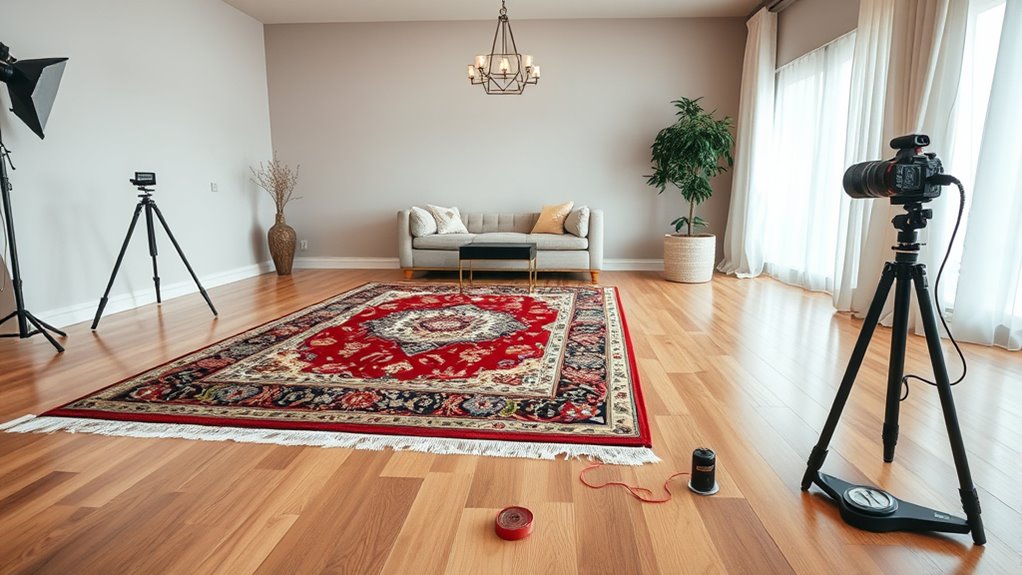
Before you start photographing your rugs, make sure your space is well-lit and clutter-free. Good lighting helps with accurate color matching, ensuring the rug’s true colors are captured. Natural light is ideal, but if you’re indoors, use soft, evenly distributed artificial lighting. Adjust your camera settings to optimize image quality—set a low ISO to reduce grain, use a small aperture for greater depth of field, and choose the right white balance to match your lighting conditions. These adjustments help preserve the rug’s colors and details, making your photos more accurate for insurance purposes. Clear, well-lit images with proper camera settings will accurately reflect your rug’s condition and appearance, streamlining the appraisal process. Utilizing low light office plants in your space can also improve ambient lighting and create a calming environment during photography.
Cleaning and Positioning Your Rug
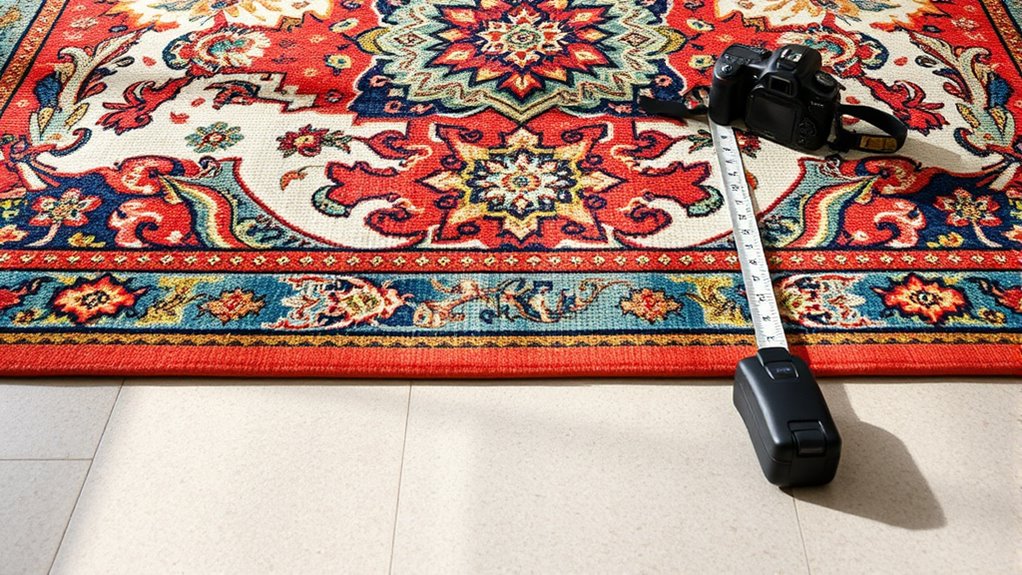
To guarantee your rug looks its best in photos, start by thoroughly cleaning it to remove dirt, dust, and stains that can obscure details. Effective rug cleaning ensures the surface is spotless, highlighting its colors and patterns clearly. Once clean, focus on rug positioning: lay it flat and smooth out any wrinkles or creases to prevent shadows and distortions. Make sure the rug is centered and aligned properly, so it appears balanced in the frame. If the rug has fringes, straighten or tidy them to enhance its appearance. Proper cleaning and positioning help your photographs accurately represent the rug’s condition and beauty, making it easier for the insurance appraiser to assess its value. Additionally, noise levels of modern heat pumps are now designed to be very quiet, so ambient sounds won’t interfere with your photographs if you’re capturing images in a space with a heat pump. This preparation sets the foundation for high-quality, detailed images.
Capturing Overall Images of the Rug
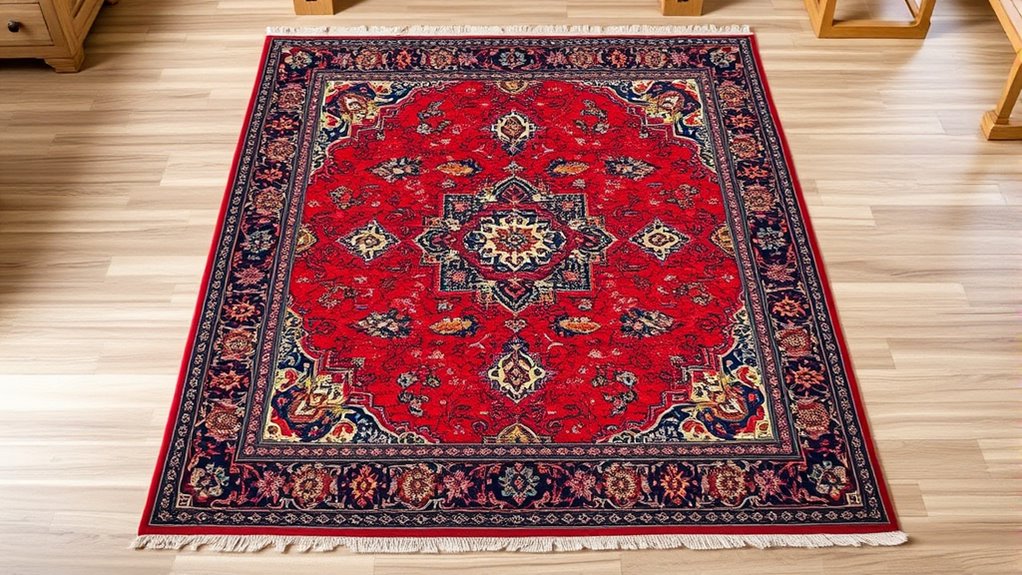
Capturing overall images of the rug requires taking clear, well-lit photos from multiple angles to showcase its full size and condition. These images provide essential context, helping appraisers understand its historical background and cultural significance. Make sure you photograph the entire rug from various perspectives, including top-down shots that highlight the pattern and craftsmanship. Use natural light whenever possible to avoid shadows that obscure details. Including images that display the rug’s edges and borders helps convey its authenticity and age, especially if it has unique regional or historical features. These detailed photos serve as a visual record, capturing the rug’s overall character and significance, making it easier for appraisers to assess its value accurately. Additionally, ensuring consistent lighting conditions across all images will help maintain clarity and detail throughout your documentation.
Taking Detailed Close-Ups of Key Features
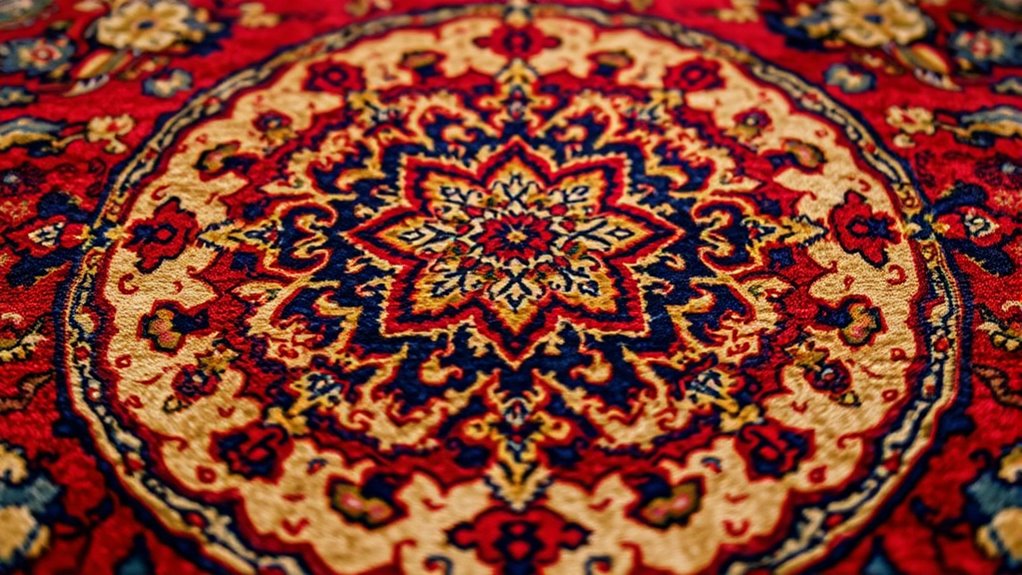
When photographing key features, focus on capturing the intricate pattern details to show the rug’s craftsmanship. Take close-ups of any wear, stains, or damage to document existing issues clearly. These details help provide a thorough record for insurance purposes. Additionally, ensure proper lighting to accurately represent color accuracy and texture in your photographs.
Focus on Pattern Details
Focusing on pattern details involves capturing close-up images of the rug’s key features to highlight its unique design elements. Pay attention to weaving techniques, such as knotting styles or weaving density, to showcase craftsmanship. These details reveal the rug’s quality and origin, making your photos more informative for the appraisal. Additionally, emphasize dye patterns, including color variations and fading, which can indicate age or specific dyeing methods. Use a macro lens or zoom in closely to clearly depict intricate motifs or borders. Confirm lighting highlights the contrast and vibrancy of the pattern without glare or shadows. Clear, detailed images of these pattern elements help the appraiser accurately assess the rug’s value and authenticity. Incorporating high-resolution images ensures every detail is captured with clarity, which is essential for an accurate appraisal.
Capture Wear and Damage
To accurately assess a rug’s condition, you need to take detailed close-up photos of wear and damage. Focus on areas showing thinning, fraying, or worn pile, and capture any tears or stains. Highlight details like irregularities in weaving techniques and fading of dye colors that indicate age or damage. Use macro shots to show fine fibers and damage patterns clearly. This helps insurers evaluate the rug’s true condition. Use a consistent lighting setup to reveal subtle flaws. Additionally, paying attention to wear & damage aspects can help identify issues that might not be immediately visible to the naked eye.
Highlighting Unique Patterns and Textures
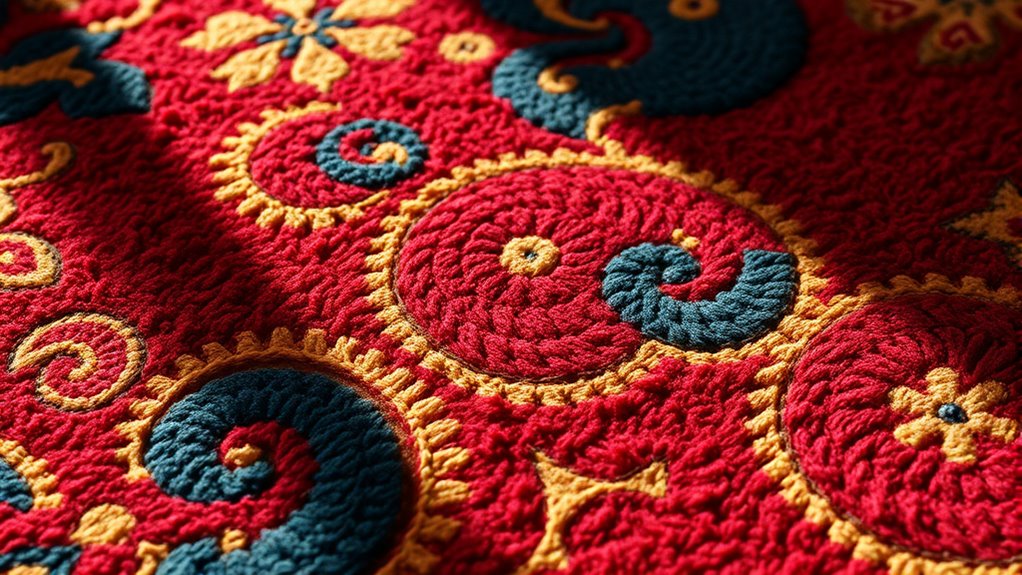
To truly capture what makes your rug special, focus on close-up details that reveal the intricate patterns and textures. Show off pattern variations by photographing different sections to highlight the design’s complexity. By emphasizing texture depth, your images will convey the rug’s craftsmanship and uniqueness effectively. Incorporating attention to detail can further enhance your photographs, ensuring every element is captured with clarity and purpose.
Capture Close-Up Details
Capturing close-up details of a rug allows you to showcase its unique patterns and textures clearly. To do this effectively, focus on maintaining color accuracy to reflect the true hues, which is crucial for insurance purposes. Use a high image resolution to capture fine details like fibers and weave intricacies. Consider these tips:
- Use a macro lens or zoom in carefully to highlight textures.
- Guarantee proper lighting to prevent shadows that distort color.
- Adjust your camera settings for ideal color accuracy and sharpness.
- Take multiple shots from different angles to capture all details.
- Decluttering your workspace can help you set up equipment more efficiently and reduce distractions during photography sessions.
Showcase Pattern Variations
Showcasing pattern variations effectively highlights a rug’s unique design features, which are essential for accurate insurance appraisals. To do this, capture images that emphasize the diversity in patterns and textures. Focus on how weaving techniques create intricate motifs and how dye variations add depth and contrast. Use multiple angles to reveal these differences clearly. Consider the following example:
| Pattern Type | Description |
|---|---|
| Geometric | Sharp lines, symmetrical shapes |
| Floral | Curved motifs, organic forms |
| Abstract | Unstructured, expressive designs |
| Technique | Effect |
| Weaving techniques | Creates detailed, textured patterns |
| Dye variations | Adds color depth and vibrancy |
| Combination | Unique, eye-catching designs |
Highlighting these features ensures a thorough visual record for appraisal. Additionally, paying attention to pattern consistency can help identify potential repairs or alterations that might affect the rug’s value.
Highlight Texture Depth
Highlighting texture depth is essential for revealing a rug’s unique patterns and craftsmanship. To achieve this, focus on capturing the rug’s true color accuracy and texture details. Use equipment choice wisely; a macro lens or a side-lighting setup can accentuate surface variations. Here are key tips:
- Position your light source at a low angle to cast gentle shadows that emphasize texture.
- Use a tripod to maintain stability and prevent blur during close-up shots.
- Adjust your camera’s settings to enhance contrast without sacrificing color accuracy.
- Experiment with different angles to highlight the rug’s depth and intricate weaves.
- Incorporate proper lighting techniques to further enhance surface details and texture visibility.
Documenting Any Existing Damage or Wear
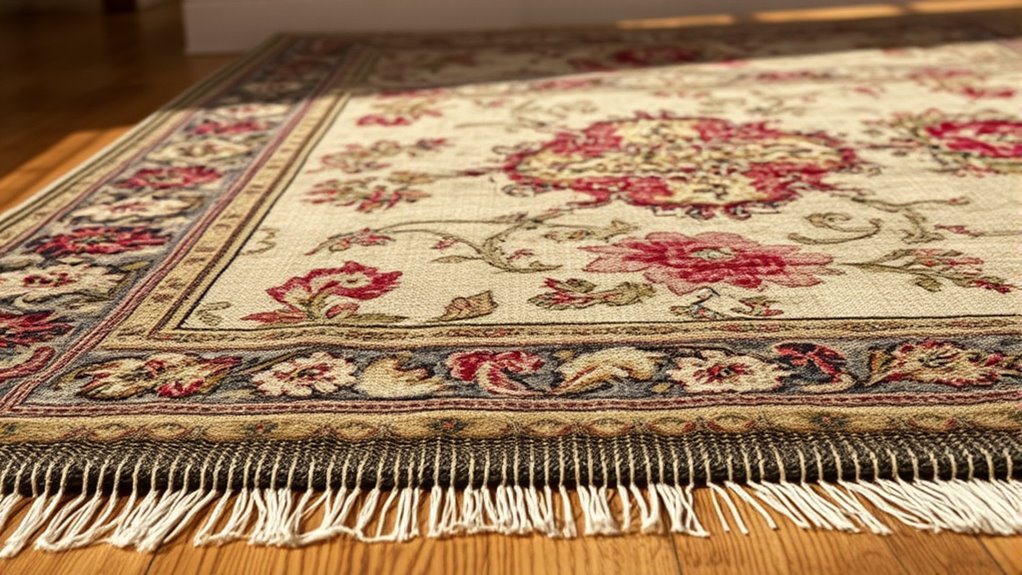
Before photographing the rug for an insurance appraisal, it’s essential to carefully document any existing damage or wear. Start by inspecting the fringe condition, noting fraying, unraveling, or missing sections. Capture close-ups of areas with tears, stains, or fading to provide clear evidence of current damage. Check the backing material for signs of looseness, holes, or deterioration, as these can affect valuation. Take detailed images from multiple angles, ensuring damage is well-documented and visible. Avoid shadows or glare that could obscure details. Clear photographs of damage help avoid disputes later and give an accurate record of the rug’s condition. Being thorough now ensures the appraisal process reflects the true state of your rug, preventing potential issues with insurance claims.
Ensuring Proper Lighting for Accurate Colors
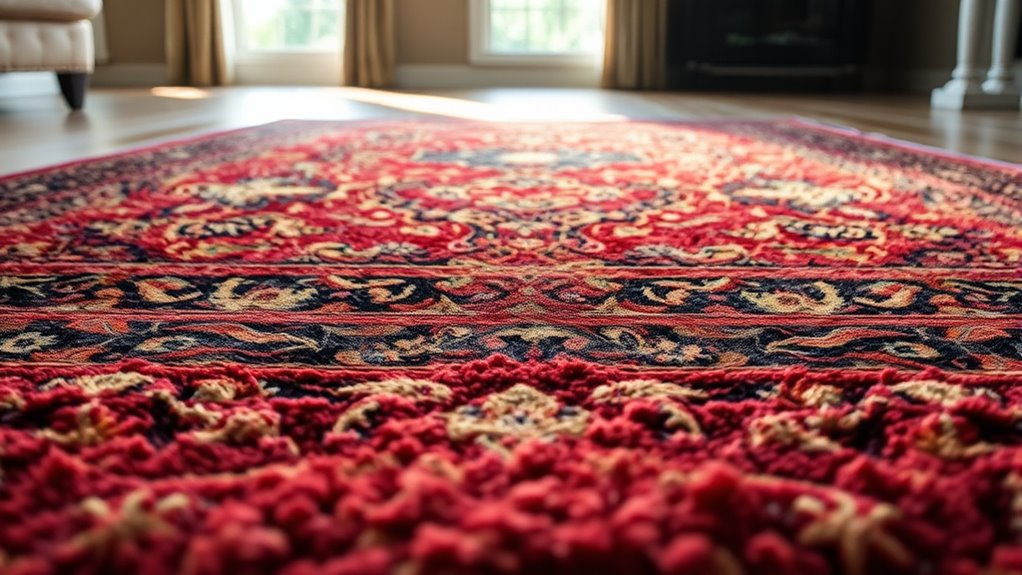
To guarantee your rug’s colors are accurately represented in photographs, proper lighting is essential. Achieving accurate color depends on controlling light temperature and minimizing shadows. Here are four tips to ensure ideal lighting:
- Use soft, diffused light to prevent harsh shadows and reflections.
- Choose a light source with a consistent color temperature, ideally around 5000K, for true color reproduction.
- Avoid fluorescent bulbs, which can distort colors through flickering or color cast.
- Photograph in natural daylight when possible, preferably during overcast conditions, to maintain color accuracy.
Proper lighting ensures your photos reflect the true hues of your rug, making it easier for insurance appraisers to assess its value accurately.
Organizing and Storing Your Photographs Effectively
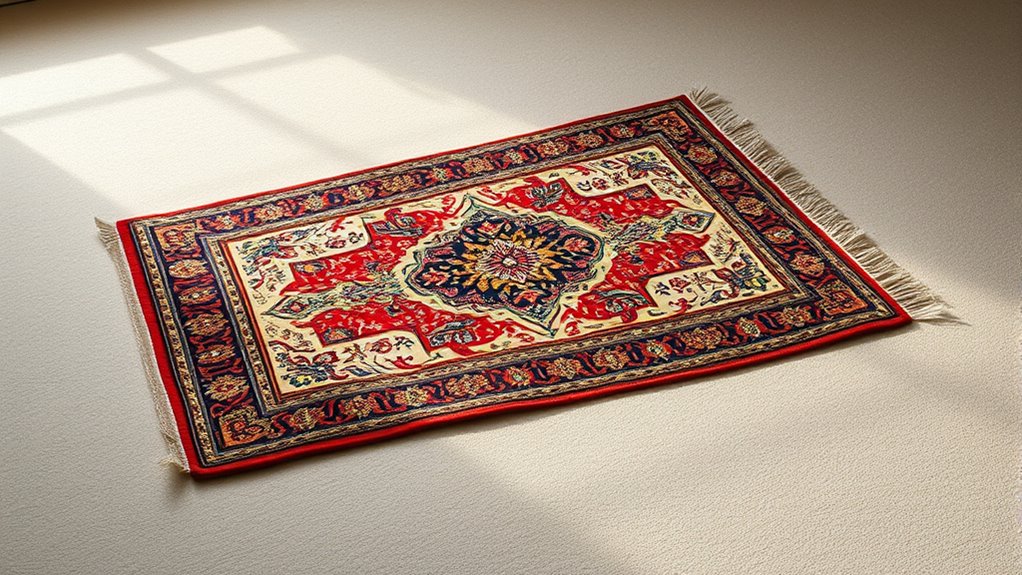
Organizing and storing your photographs properly is essential to keeping your documentation accessible and secure. Use clear labeling and consistent naming conventions to track each rug’s details, such as date, location, and framing techniques used. Consider digital storage solutions like cloud services or external drives to prevent data loss. Create folders for different rugs or projects, and back up your images regularly. To stay organized, use a table like this:
| Rug ID | Photo Date | Storage Solution |
|---|---|---|
| 001 | 2024-04-01 | External Hard Drive |
| 002 | 2024-04-02 | Cloud Storage |
| 003 | 2024-04-03 | Local Folder |
| 004 | 2024-04-04 | NAS Device |
This helps guarantee your photographs are easy to find and protected, no matter the situation.
Frequently Asked Questions
How Many Photos Are Recommended for a Comprehensive Rug Appraisal?
For a thorough rug appraisal, you should take at least 8-10 photos from various angles, including close-ups of details and any damage. Use consistent lighting conditions to highlight the rug’s color and texture, ensuring true representation. Capture straight-on shots, side views, and close-ups of unique patterns or flaws. This variety helps appraisers assess the rug’s condition accurately, providing a detailed visual record for insurance purposes.
Should I Include Measurements or Scale References in My Photos?
Think of your rug like a piece of art—you want viewers to understand its size instantly. Including scale references and measurement in your photos helps the appraiser see the true dimensions, preventing misinterpretation. Without measurement inclusion, they might guess, risking inaccuracies. Always include a common object or a ruler next to the rug to give context. This simple step guarantees your appraisal reflects your rug’s actual size and value.
Is It Necessary to Photograph Both Sides of the Rug?
You should photograph both sides of the rug, including a clear front view and side view, to capture its full condition and details. The front view shows the design, while the side view reveals thickness and wear. Including these angles helps provide a thorough record for insurance purposes, ensuring the insurer can accurately assess the rug’s value and condition. Always make sure the lighting highlights all important features.
What File Formats and Resolutions Are Best for Insurance Photos?
You might think choosing the perfect file format and resolution is rocket science, but it’s simpler than that. For insurance photos, use JPEGs at 300 dpi to balance quality and file size. Avoid over-compression, as it ruins detail, and stay away from TIFFs unless specified. Your goal: clear, detailed images that stand up to photo editing and aren’t marred by image compression, ensuring your rug’s value stays intact.
How Soon Should I Update Photos After Rug Repairs or Restorations?
You should update your photos promptly after rug repairs or restorations to ensure your documentation accurately reflects the current condition. The timing of updates is vital; wait until repairs are complete and any restoration work has settled. Incorporate clear repair documentation in your new photos, highlighting specific repairs. Doing this guarantees your insurance claims are supported by recent, detailed images, making the process smoother if you need to file a claim later.
Conclusion
By following these steps, your rug’s story will shine through your photos, much like a well-loved book’s pages reveal its history. Clear, detailed images guarantee your appraisal captures the true beauty and condition of your rug, making the insurance process smoother. Remember, each photo is a brushstroke in the masterpiece of your documentation. With a little effort, your rug’s story will be beautifully preserved, ready to stand the test of time and appraisal.
